- Instructors: Prof. Alan Mislove and Prof. Christo Wilson
- Contact:
amislove@ccs.neu.eduandcbw@ccs.neu.edu- Use
cs5750f13-staff@ccs.neu.edufor everything other than personal issues
- Use
- Office: 250 WVH (Mislove) and 348 WVH (Wilson)
- Office Hours: 4:30-6:00 Mondays (Mislove) and TBA (Wilson)
- Teaching Assistant: Arash Molavi Kakhki
- Contact:
cs5750f13-staff@ccs.neu.edu - Office: 266 WVH
- Office Hours: TBA
Course overview
Syllabus, schedule, and policies
Who's who
Course information
- Web page: http://www.ccs.neu.edu/~cbw/socialnetworks.html
- Forum: https://piazza.com/northeastern/fall2013/cs5750
- Textbook(s):
- Recommended: Easley, David and Kleinberg, Jon. Networks, Crowds, and Markets: Reasoning About a Highly Connected World. University Press, Cambridge, UK. 2010.
- Optional: Watts, Duncan J. Six Degrees: The Science of a Connected Age. W. W. Norton & Company, 2009.
- Optional:Shirky, Clay. Here Comes Everybody: The Power of Organizing Without Organizations. Penguin Press, 2008.
Paper Presentations and Summaries
- Course is primarily research-oriented; you must be prepared and participate
- Require 500-word summary of readings by midnight before class
- Represents 10% of your grade, in aggregate
- Must be ASCII text
- Students will be presenting the papers we discuss
- High-quality presentation, approx. 15-20 minutes
- Also bring a list of discussion questions
- You are in charge of the class!
- Represents 10% of your grade, in aggregate
- Sign-up sheet linked from Piazza
Homeworks
- There are four homeworks throughout the semester
- Practical implementations of concepts in class
- Hands-on experience with real data, systems, etc
- Will be completed in teams of two
- You will pick your teammate
- You can switch teammates between projects
- Both teammates must put in equal effort
- You are given four slip days to use on homeworks
- Can turn in late with no penalty
- All team members must have a slip day to use it
- First homework handed out today!
Course Project
- There is a course research project you must complete with a partner
- Topic of your own choosing, in consultation with course staff
- Research project, not a programming project
- 40% of your overall grade!
- Example ideas of course projects:
- Building an iOS/Android app to conduct an experiment
- Using Amazon Mechanical Turk to solve a problem
- Analysis of large-scale Twitter data
- Upcoming deadlines for course project:
- Meet with instructors: Sept. 30
- Project proposal (~5 pages): Oct. 9
- Interim report (~10 pages): Nov. 6
- Project presentation (~20 min): Nov. 20 - Dec. 4
- Final report (~20 pages): TBA
Exams
There are no exams.
Turnin system
- All summaries and homeworks will be submitted using our
turninsystem - You must have a CCIS Linux account
- If not, register for one immediately
- Emailed submissions will get no credit
- You must first register with the system:
bash$ /course/cs5750f13/bin/register-student ID About to register user 'USER' with student ID 'ID'. Is this correct? [yn]
bash$ /course/cs5750f13/bin/turnin summary02 ~/cs5750/summary02.txt Added file summary02.txt (28392 bytes) Successfully submitted summary02 for user amislove (confirmation ZiwKE5). Submitted a total of 1 files (28392 bytes) in 0 directories.
On cheating
- Do not cheat.
- Ask the course staff if you are unsure.
Lecture 1
Basic Network Theory
Why study networks?
- Networks represent interaction among entities
- Entities are nodes in the network
- Edges represent interaction between two entities
- Examples include
- Information transmission
- Credit and financial flows
- Friendship
- Trust and distrust
- Disease and epidemics
- Interactions (therefore networks) usually have structure
Citations between blogs during 2004 US election
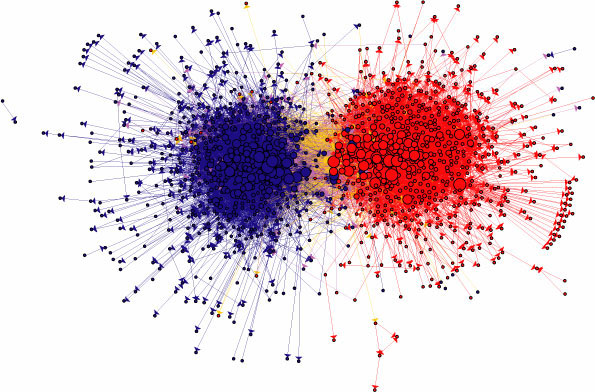
Friendship between members of a karate club
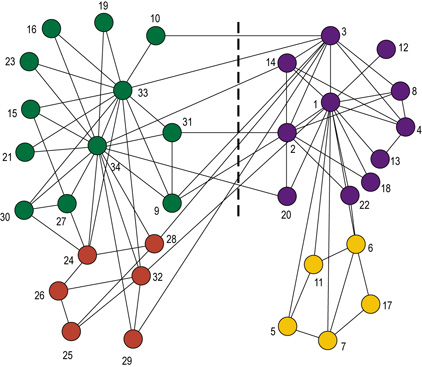
Co-authorship networks of scientists
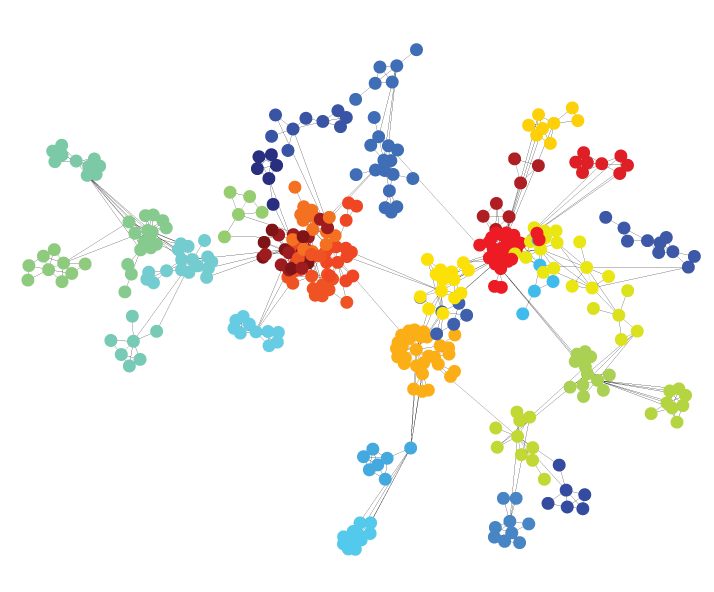
Connections between routers on the Internet
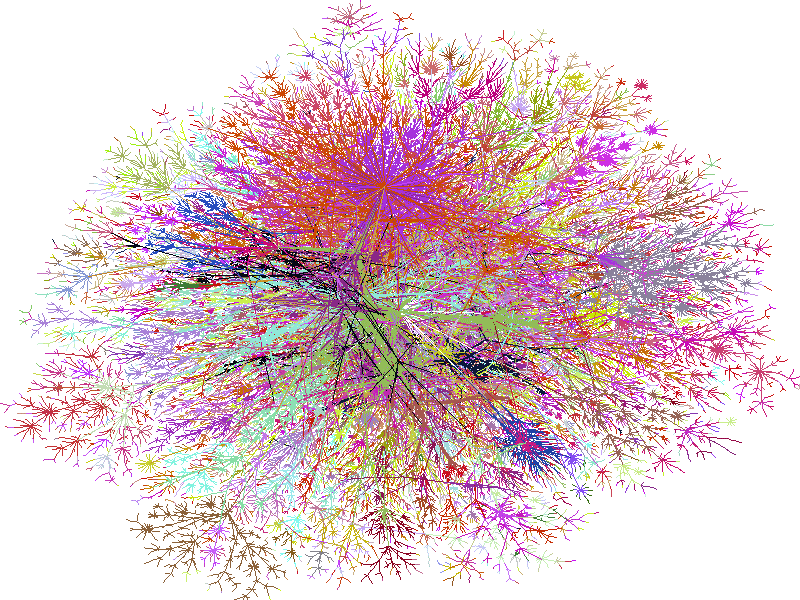
Connections between friends
Nodes are colored by body weight

Interactions between proteins in human cells

Transportation networks
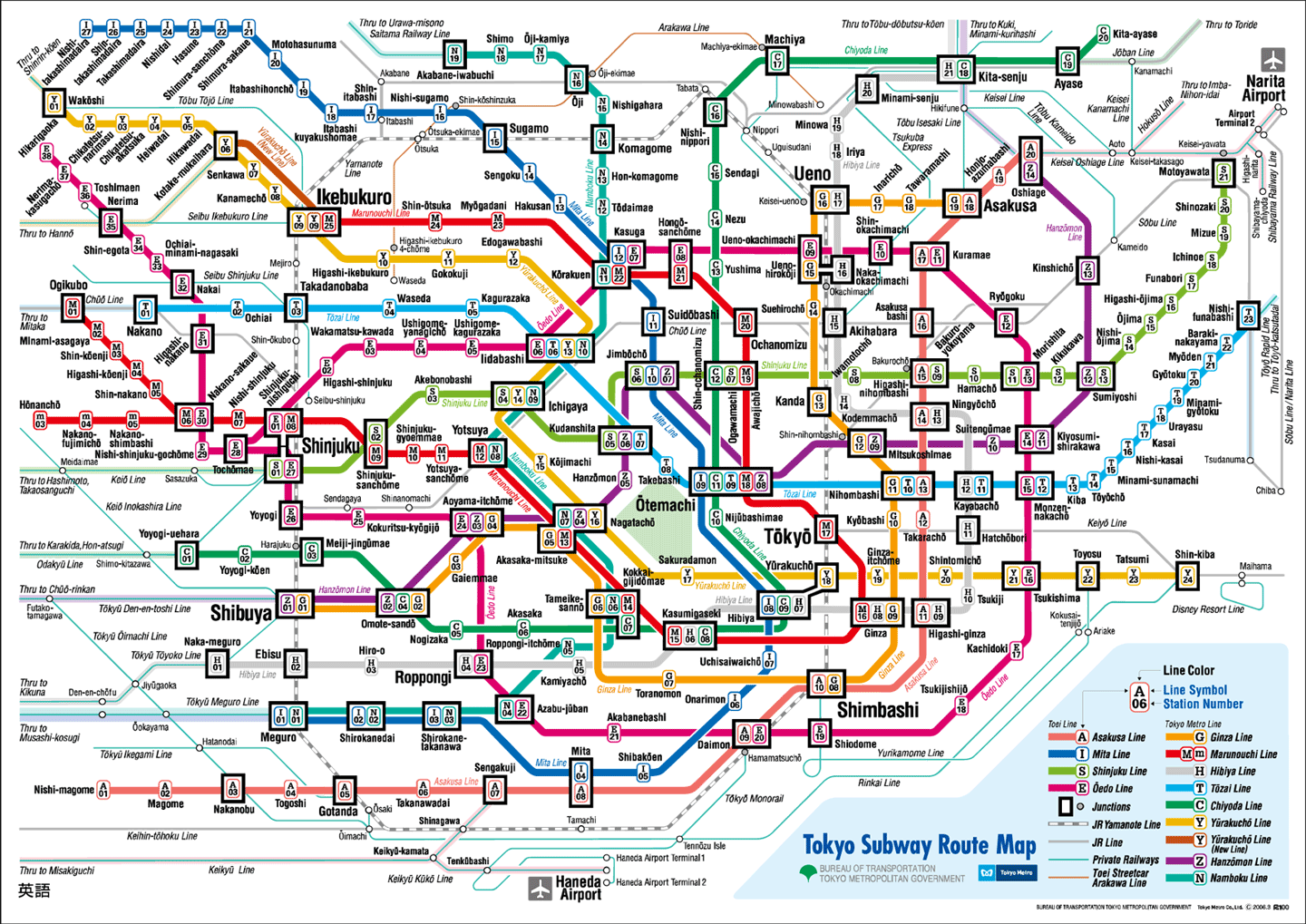
7 bridges of Köningsburg

- Graph theory born with Euler's bridges problem
- No way to cross all bridges exactly once and return to starting point
- Convert city map into graph; prove no complete cycle exists
How do we represent networks?
- A network (graph) is a set of vertices (nodes) connected by edges (links)
- Typically represented as \(G=(V,E)\)
- \(V=\{v_1, v_2, ... v_n\}\) is the set of vertices
- \(E=\{e_1, e_2, ... e_n\}\) is the set of edges, with \(e_i=(v_{from}, v_{to})\)
- Graphs can be directed or undirected
- Links in directed graphs have a direction:
- Links in undirected graphs have no direction:
- When are directed/undirected graphs appropriate?
- Links in directed graphs have a direction:
Network features
- Edges may have a weight attached to them
- Can represent distance, current usage, cost, strength
- Often used to find "low-cost" paths in the network
- Multiple edges may be allowed between nodes
- An edge may go from a node to itself
- This is known as a self-loop
Walks, paths, and cycles
- We often reason about sequences of edges on graphs
- We can define the following for \(G=(V,E)\):
- A walk is a sequence of edges \(\{v_i,v_j\},\{v_j,v_k\},...\{v_m,v_n\}\)
- A trail is a walk with distinct edges
- A path is a walk with distinct nodes
- The sequence \(\{v_i, v_j, ... v_n\}\) contains no duplicates
- A cycle is a path that start and end at the same node
- A geodesic is a path containing the minimum number of edges
- The length of a walk is the number of edges on the walk
- For directed graphs, can only follow edges in intended direction
Random walks
- Recall a walk is a series of sequential edges \(\{v_i,v_j\},\{v_j,v_k\},...\{v_m,v_n\}\)
- Often use random walks to understand graph structure
- Walk formed by starting a vertex \(v_i\)
- At each step, select random outgoing edge from current vertex
- Probability of selecting each outgoing edge is $$\frac{1}{{\rm outdegree}(v)}$$
- Used in many algorithms (e.g., PageRank)
Stationary distribution and mixing time
- One application of random walks: stationary distribution
- Suppose we take longer and longer random walks....
- Eventually probability of being at any node stabilizes
- This distribution is called stationary distribution
- Can be used to measure mixing time: how long to reach stationary distribution?
- Example of a graph with high mixing time?
- Low mixing time?
- Can also define:
- Hit time \(h(u,v)\): expected random walk length from \(u\) to \(v\)
- Commute time \(c(u,v) = h(u,v) + h(v,u)\)
Shortest paths
- A geodesic is also known as a shortest path
- Path with minimal hops from \(A\) to \(B\)
- Often, we want to find such a path
- Djikstra's algorithm is useful for this
- Gives shortest paths to all destinations from single source
- Can also measure average path length of a graph: $$\frac{\sum_{u,v\in V; u\neq v} {\rm path\_length}(u,v)}{N * (N-1)}$$ (pairs of nodes with no path between them are ignored)
Radius, diameter, and eccentricity
- Often interested in "how far" nodes are in a graph
- Average path length on doesn't say much about worst off/best off nodes
- Define eccentricity of a node to be $$e(v) = \max_{w\in V, w\neq v} {\rm path\_length}(v,w)$$
- Then can define:
- The radius of a graph is $$\min_{v\in V} e(v)$$
- The diameter of a graph is $$\max_{v\in V} e(v)$$
Connectivity and components
- An undirected graph is connected if $$\forall_{v_i, v_j} \exists\ {\rm path}(v_i, v_j)$$
- If not, a graph can be decomposed in components
- A directed graph can
- Weakly connected if the graph is connected viewed undirected
- Strongly connected if $$\forall_{v_i, v_j} \exists\ {\rm directedpath}(v_i, v_j)$$
- Example of a weakly but not strongly connected graph:
Special graph structures
Complete graph
Ring
Star
Tree
Bipartite
Planar
Subgraphs
- \(S\) is a subgraph of \(G\) if $$S=(V_S,E_S)\ \ \ {\rm and}\ \ \ V_S\subseteq V_G, E_S\subseteq E_G$$ (if so, \(G\) is called a supergraph of \(S\))
- \(S\) is a spanning subgraph if \(V_S=V_G\)
- \(S\) is a spanning tree if \(S\) is a spanning subgraph and a tree
- The subgraph induced by \(V^* \subset V\) as the edge set $$\{(u,v)\in E\ \ {\rm s.t.}\ \ u\in V^*, v\in V^*\}$$
- A subgraph is a clique if it is complete
Isomorphism
- Two graphs \(G\) and \(H\) are isomorphic if there exists a bijection $$f : V_G \rightarrow V_H$$ and $$(v_i, v_j) \in E_G \iff (f(v_i), f(v_j)) \in E_H$$
- Graph isomorphism problem is determining whether such a bijection exists
- Does it sound hard or easy?
Isomorphism example
- \(f(a)=1, f(b)=6, f(c)=8, f(d)=3, f(g)=5, f(h)=2, f(i)=4, f(j)=7\)
Neighborhood and degree
- The neighborhood of node \(i\) is the set of nodes \(i\) is connected to $$N(i) = \{v\ \ {\rm s.t.}\ \ (i, v)\in E\}$$
- The degree of \(i\) is the size of the neighborhood \(|N(i)|\)
- For directed graphs, slightly more complicated
- Define outdegree as the number of outgoing edges from \(i\)
- Define indegree as the number of incoming edges to \(i\)
- Define average [out,in]degree as the average across all nodes
Degree distributions
- The degree distribution \(p(d)\) is the probability distribution of degrees
- \(p(1) = \frac{1}{6}\), \(p(2) = \frac{1}{2}\), \(p(3) = \frac{1}{6}\), \(p(d>4) = 0\)
- The \(k_{nn}\) distribution is average neighbors' degree based on degree
- \(k_{nn}(1) = 3\)
- \(k_{nn}(2) = \frac{\frac{2+3}{2} + \frac{2+3}{2} + \frac{2+2}{2}}{3} = \frac{7}{3}\)
- \(k_{nn}(3) = \frac{2+2+1}{3} = \frac{5}{3}\)
- \(k_{nn}(d>4)\ {\rm undefined}\)
Assortativity
- Captures linking behavior of nodes
- Can be used to measure "homophily" of any node property
- Typically used to measure degree correlation (i.e., do high degree nodes link to other high degree nodes?)
- Defined as Pearson correlation coefficient of node degrees
- Range is \(r\in [-1,1]\), 0 represents no correlation
- Graph with \(r<0\) is disassortative, \(r>0\) is assortative
- For directed networks, can define \(r(in,out)\), \(r(in,in)\), etc
- Why would assortativity be useful to understand?
Clustering
- Often interested level of node clustering
- Informally, how often are my friends also friends?
- First, define the clustering coefficient of a node \(i\) as $$c(i) = {n \over d_i (d_i-1)}$$ where \(d_i\) is the degree of \(i\)
- Then, average clustering coefficient is $$C(G) = {\sum_{v\in V} c(v) \over |V|}$$
- What is the avg. clustering coefficient of the graph shown?
Centrality
- Often interested in "importance" of nodes; referred to as centrality
- Many ways to measure; most accepted is betweenness centrality
- Essentially, how much does this node connect others?
- Defined as $$g(v) = \frac{\sum_{s\neq v\neq t} \frac{\sigma_{st}(v)}{\sigma_{st}}}{(N-1)(N-2)}$$ where
- \(N\) is the number of nodes
- \(\sigma_{st}\) is number of shortest paths from \(s\) to \(t\)
- \(\sigma_{st}(v)\) is the number of these that pass through \(v\)
Betweenness centrality example
| a | b | c | d | e | |
|---|---|---|---|---|---|
| a | - | a-b | a-b-c | a-b-c-d, a-b-e-d | a-b-e |
| b | b-a | - | b-c | b-c-d, b-e-d | b-e |
| c | c-b-a | c-b | - | c-d | c-b-e, c-d-e |
| d | d-c-b-a, d-e-b-a | d-c-b, d-e-b | d-c | - | d-e |
| c | e-b-a | e-b | e-b-c, e-d-c | e-d | - |
$$\begin{array}{rcl}
g(c) & = & \frac{\frac{\sigma_{ab}(c)}{\sigma_{ab}} + \frac{\sigma_{ad}(c)}{\sigma_{ad}} + \frac{\sigma_{ae}(c)}{\sigma_{ae}} +\ ...}{4 * 3}\\
& = & \frac{0 + 0.5 + 0 +\ ...}{12}\\
& = & \frac{1}{6}\\
\end{array}$$
Degeneracy and \(k\)-cores
- Often interested in how graphs break down (i.e., how resilient is a graph?)
- Can define \(k\)-core of a graph as
- A maximal connected subgraph (i.e., the largest subgraph)
- Where all vertices have degree \(k\)
- How to determine if a \(k\)-core exists? (for a fixed \(k\))
- Recursively remove all vertices with degree < \(k\)
- If you are left with no vertices, no \(k\)-core exists
- What kind of graph would have a large \(k\)-core? A small \(k\)-core?
\(k\)-core example
k:
Representing graphs
- Adjancency matrix $$\left[ \begin{array}{ccccc} 1 & 1 & 0 & 0 & 0 \\ 1 & 1 & 1 & 1 & 1 \\ 0 & 1 & 1 & 0 & 1 \\ 0 & 1 & 0 & 0 & 1 \\ 0 & 1 & 1 & 0 & 1\\ \end{array} \right]$$
- Adjancency list $$\begin{array}{lllll} a & b\\b & a & c & d & e\\c & b & e\\ ...\\\end{array}$$
- Edge list $$\begin{array}{ll} a & b\\b & c \\ b & d\\ ...\\\end{array}$$
Credits
Slides and material are borrowed from many places, including:
- Jon Crowcroft's Priciples of Communication course, University of Cambridge
- Daron Acemoglu's and Asu Ozdaglar's OpenCourseWare 6.207 Networks course, MIT
- Dragomir Radev's Network Theory class, Columbia University
Slides were developed using Panic's Coda web-editing software, Google's I/O HTML5 slide code, and sigma.js.